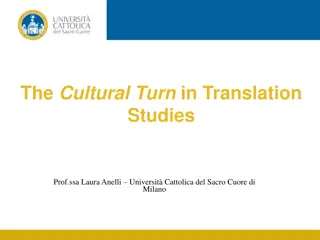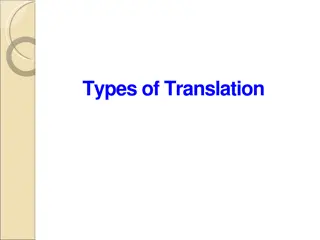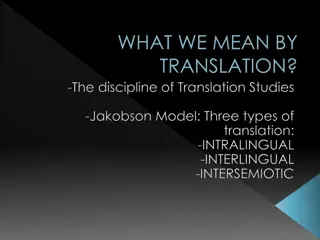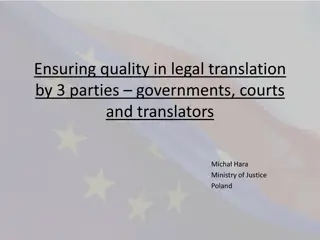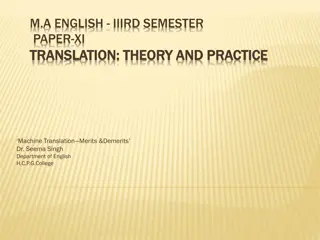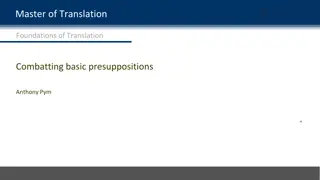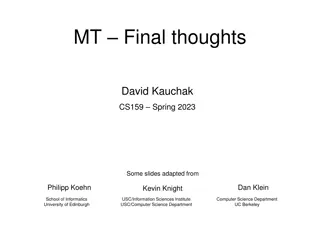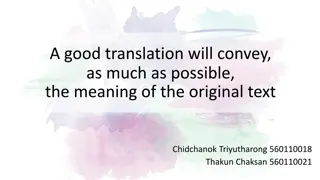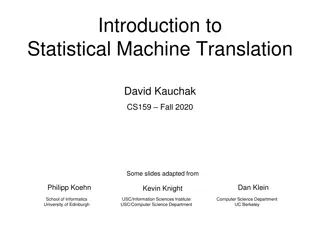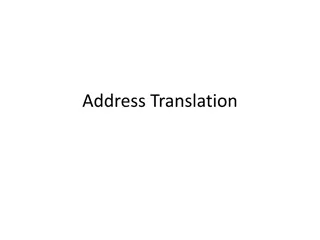Comprehensive Overview of Translation: History, Definition, Importance, and Characteristics
Delve into the rich history, definition, importance, and key characteristics of translation. Uncover the evolution from the 3rd century BC to modern demands. Explore the vital role of competent translators, cultural fluency, and essential tools like dictionaries in bridging linguistic gaps.
Download Presentation

Please find below an Image/Link to download the presentation.
The content on the website is provided AS IS for your information and personal use only. It may not be sold, licensed, or shared on other websites without obtaining consent from the author.If you encounter any issues during the download, it is possible that the publisher has removed the file from their server.
You are allowed to download the files provided on this website for personal or commercial use, subject to the condition that they are used lawfully. All files are the property of their respective owners.
The content on the website is provided AS IS for your information and personal use only. It may not be sold, licensed, or shared on other websites without obtaining consent from the author.
E N D
Presentation Transcript
TRANSLATION: A BROAD OVERVIEW TRANSLATION: A BROAD OVERVIEW WEAVING ITS THREADS TOGETHER WEAVING ITS THREADS TOGETHER Dr Eyhab Bader Eddin English Department, Faculty of Languages and Translation King Khalid University October 1, 2019
POINTS TO DISCUSS TODAY: 1. Translation History 2. Translation Definition 3. Translation Importance 4. Translation Modes 5. Distinction between Translation and interpreting 6. Real Examples 7. Difficulties
HISTORY The translation of the Hebrew Bible into Greek in the 3rd century BC is regarded as the first major translation in the Western world. The dispersed Jews had forgotten Hebrew, their ancestral language, and needed the Bible to be translated into Greek to be able to read it.
DEFINITION The process of replacing a text in one language by a text in another. An act through which the content of a text is transferred from the source language into the target language.
TRANSLATION IMPORTANCE The need for translation has been apparent since the earliest days of human interaction, whether it be for emotional, trade or survival purposes. Spread of civilizations, sciences, knowledge, religions, negotiating treaties and accords in peace and war. The demand for translation services has continued to develop and is now more vital than ever, with businesses acknowledging the inability to expand internationally or succeed in penetrating foreign markets without translating marketing material
CHARACTERISTICS of a Competent Translator A. Linguistic command of both SL and TL. B. Thorough knowledge of the subject matter of the translated text. C. Inspiration, flair for language D. Cultural acquaintance with the TL culture. E. Flexibility in understanding the same words in different contexts (any examples?)
AN IMPORTANT TOOL OF A GOOD TRANSLATOR IS A GOOD DICTIONARY Dictionaries come in many shapes and sizes They are aimed at different groups of users. No dictionary is totally comprehensive, in the sense that it contains ALL the words in the language. Even the great TWENTY-VOLUME second edition of the Oxford English Dictionary, with its 291, 500 entries) needs to be reviewed and updated for new senses of existing words AND new words coined.
WHAT INFORMATION COULD A GOOD DICTIONARY PROVIDE TO ITS USER? learning new words learning the origin of a word checking the parts of speech of a word learning multiple meanings of a word learning how to pronounce a word constructing a sentence using the word
FOLLOWING IS A LIST OF THE MOST FAMOUS RELIABLE DICTIONARIES YOU MAY BUY AND KEEP FOR YOUR OWN
GIRD YOUR LOINS AND WORK ON THE FOLLOWING SET OF STATEMENTS Australian taxi protests stop traffic .. Australia and Indonesia restore full military ties .
Flags flew at half-mast across the country on a national day of mourning Trump threatens Iran over uranium enrichment
DISTINCTION BETWEEN TRANSLATION AND INTERPRETING Translation Written language Author and addresses are NOT present Result? No overt interaction or direct feedback Tools available, and not under the pressure of time Interpreting Oral language BOTH Author and addresses are present Result? Overt interaction and direct feedback Able to translate in both directions on the spot, without using dictionaries or other supplemental reference materials Must have extraordinary listening abilities, especially for simultaneous interpreting Need to process and memorize the words that the source-language speaker is saying now, while simultaneously outputting in the target language the translation of words Must also possess excellent public speaking skills and the intellectual capacity to instantly transform idioms, colloquialisms and other culturally-specific references
WHY DIFFICULT? No breaks Specialized vocabulary and high levels of speech (thorough knowledge of the subject matter) Speed Stress Decalage (ear to voice span): the time between the speaker s utterance and interpreter s interpretation of that utterance. Listening while speaking
For further discussion, please contact me at ealdeen@kku.edu.sa




